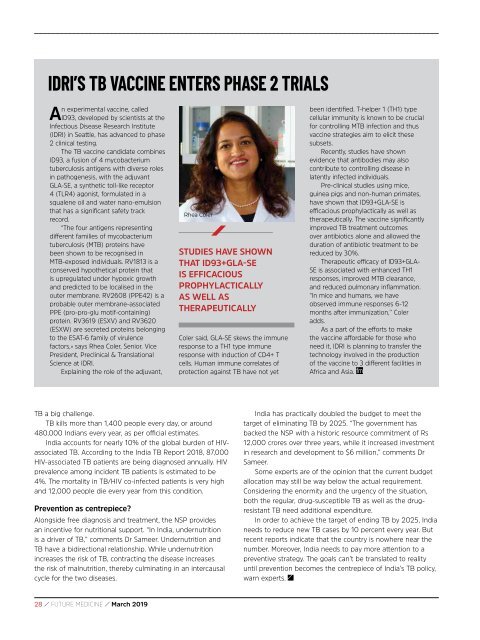March 2019 digital v1
Create successful ePaper yourself
Turn your PDF publications into a flip-book with our unique Google optimized e-Paper software.
IDRI’S TB VACCINE ENTERS PHASE 2 TRIALS<br />
An experimental vaccine, called<br />
ID93, developed by scientists at the<br />
Infectious Disease Research Institute<br />
(IDRI) in Seattle, has advanced to phase<br />
2 clinical testing.<br />
The TB vaccine candidate combines<br />
ID93, a fusion of 4 mycobacterium<br />
tuberculosis antigens with diverse roles<br />
in pathogenesis, with the adjuvant<br />
GLA-SE, a synthetic toll-like receptor<br />
4 (TLR4) agonist, formulated in a<br />
squalene oil and water nano-emulsion<br />
that has a significant safety track<br />
record.<br />
“The four antigens representing<br />
different families of mycobacterium<br />
tuberculosis (MTB) proteins have<br />
been shown to be recognised in<br />
MTB-exposed individuals. RV1813 is a<br />
conserved hypothetical protein that<br />
is upregulated under hypoxic growth<br />
and predicted to be localised in the<br />
outer membrane. RV2608 (PPE42) is a<br />
probable outer membrane-associated<br />
PPE (pro-pro-glu motif-containing)<br />
protein. RV3619 (ESXV) and RV3620<br />
(ESXW) are secreted proteins belonging<br />
to the ESAT-6 family of virulence<br />
factors,» says Rhea Coler, Senior. Vice<br />
President, Preclinical & Translational<br />
Science at IDRI.<br />
Explaining the role of the adjuvant,<br />
Rhea Coler<br />
STUDIES HAVE SHOWN<br />
THAT ID93+GLA-SE<br />
IS EFFICACIOUS<br />
PROPHYLACTICALLY<br />
AS WELL AS<br />
THERAPEUTICALLY<br />
Coler said, GLA-SE skews the immune<br />
response to a TH1 type immune<br />
response with induction of CD4+ T<br />
cells. Human immune correlates of<br />
protection against TB have not yet<br />
been identified. T-helper 1 (TH1) type<br />
cellular immunity is known to be crucial<br />
for controlling MTB infection and thus<br />
vaccine strategies aim to elicit these<br />
subsets.<br />
Recently, studies have shown<br />
evidence that antibodies may also<br />
contribute to controlling disease in<br />
latently infected individuals.<br />
Pre-clinical studies using mice,<br />
guinea pigs and non-human primates,<br />
have shown that ID93+GLA-SE is<br />
efficacious prophylactically as well as<br />
therapeutically. The vaccine significantly<br />
improved TB treatment outcomes<br />
over antibiotics alone and allowed the<br />
duration of antibiotic treatment to be<br />
reduced by 30%.<br />
Therapeutic efficacy of ID93+GLA-<br />
SE is associated with enhanced TH1<br />
responses, improved MTB clearance,<br />
and reduced pulmonary inflammation.<br />
“In mice and humans, we have<br />
observed immune responses 6-12<br />
months after immunization,’’ Coler<br />
adds.<br />
As a part of the efforts to make<br />
the vaccine affordable for those who<br />
need it, IDRI is planning to transfer the<br />
technology involved in the production<br />
of the vaccine to 3 different facilities in<br />
Africa and Asia.<br />
TB a big challenge.<br />
TB kills more than 1,400 people every day, or around<br />
480,000 Indians every year, as per official estimates.<br />
India accounts for nearly 10% of the global burden of HIVassociated<br />
TB. According to the India TB Report 2018, 87,000<br />
HIV-associated TB patients are being diagnosed annually. HIV<br />
prevalence among incident TB patients is estimated to be<br />
4%. The mortality in TB/HIV co-infected patients is very high<br />
and 12,000 people die every year from this condition.<br />
Prevention as centrepiece?<br />
Alongside free diagnosis and treatment, the NSP provides<br />
an incentive for nutritional support. “In India, undernutrition<br />
is a driver of TB,” comments Dr Sameer. Undernutrition and<br />
TB have a bidirectional relationship. While undernutrition<br />
increases the risk of TB, contracting the disease increases<br />
the risk of malnutrition, thereby culminating in an intercausal<br />
cycle for the two diseases.<br />
India has practically doubled the budget to meet the<br />
target of eliminating TB by 2025. “The government has<br />
backed the NSP with a historic resource commitment of Rs<br />
12,000 crores over three years, while it increased investment<br />
in research and development to $6 million,” comments Dr<br />
Sameer.<br />
Some experts are of the opinion that the current budget<br />
allocation may still be way below the actual requirement.<br />
Considering the enormity and the urgency of the situation,<br />
both the regular, drug-susceptible TB as well as the drugresistant<br />
TB need additional expenditure.<br />
In order to achieve the target of ending TB by 2025, India<br />
needs to reduce new TB cases by 10 percent every year. But<br />
recent reports indicate that the country is nowhere near the<br />
number. Moreover, India needs to pay more attention to a<br />
preventive strategy. The goals can’t be translated to reality<br />
until prevention becomes the centrepiece of India’s TB policy,<br />
warn experts.<br />
28 / FUTURE MEDICINE / <strong>March</strong> <strong>2019</strong>


















